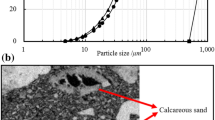Abstract
Gas Hydrate Bearing Sediments (GHBS) are natural soil deposits that contain methane hydrate inside their pores and they have been considered as a potential energy resource. Deformation behavior and change in shear strength of sediments are not clearly understood on the occasion of methane hydrate production and its modeling poses great challenges. In this study, a new GHBS model based on unified hardening framework has been proposed with less and easily determined model parameters. This analytical model incorporates modified Cam-clay yield surface, plus the effect of hydrate saturation parameters to capture the mechanical behavior of GHBS. Comparisons of tri-axial compression tests with model simulations have been conducted to show the proposed model is able to predict the mechanical behavior of GHBS at different hydrate saturations and confinement conditions.










Similar content being viewed by others
References
Collett TS (2002) Energy resource potential of natural gas hydrates. AABG Bull 86:1971–1992
Hyodo M, Li Y, Yoneda J, Nakata Y, Yoshimoto N, Nishimura A (2013) Effects of dissociation on the shear strength behaviour of methane hydrate-bearing sediments. Mar Pet Geol 51:52–62
Kvenvolden KA (1999) Potential effects of gas hydrate on human welfare. Proc Natl Acad Sci 96:3420–3426
Lee K, Chan D, Lam K (2004) Constitutive model for cement treated clay in a critical state frame work. J Jpn Geotech Soc Soils Found 44:69–77
Liu F, Kou XY, Jiang MJ, Wu XF (2013) Triaxial shear strength of synthetic hydrate-bearing sediments. Chin J Geotech Eng 35:1565–1572
Mahajan D, Taylor CE, Mansoori GA (2007) An introduction to natural gas hydrate/clathrate: the major organic carbon reserve of the Earth. J Petro Sci Eng 56:1–8
Masui A, Haneda H, Ogata Y, Aoki K (2005) Effects of methane hydrate formation on shear strength of synthetic methane hydrate sediments. In: Proceeding of the fifteenth international offshore and polar engineering conference, Seoul, Korea, pp 364–369
Masui A, Haneda H, Ogata Y, Aoki K (2007) Mechanical properties of sandy sediment containing marine gas hydrates in deep sea offshore Japan. J Manag 26:839–861
Miyazaki K, Masui A, Sakamoto Y, Aoki K, Tenma N, Yamaguchi T (2011) Triaxial compressive properties of artificial methane-hydrate-bearing sediment. J Geophys Res Solid Earth 116:1–11
Miyazaki K, Tenma N, Aoki K, Yamaguchi TA (2012) Nonlinear elastic model for triaxial compressive properties of artificial methane-hydrate-bearing sediment samples. Energies 5:4057–4075
Rutqvist J, Moridis GJ (2007) Numerical studies on the geomechanical stability of hydrate-bearing sediments. SPE J 14:267–282
Sultan N, Garziglia S (2011) Geomechanical constitutive modelling of gas-hydrate-bearing sediments. In: Proceedings of the 7th international conference on gas hydrates, Edinburgh, pp 1–11
Winters WJ, Waite WF, Mason DH, Gilbert LY, Pecher IA (2007) Methane gas hydrate effect on sediment acoustic and strength properties. J Petro Sci Eng 56:127–135
Yao YP, Sun DA (2000) Application of Lade’s Criterion to Cam-Clay Model. J Eng Mech 127:112–119
Yao YP, Sun DA, Luo T (2004) A critical state model for sands dependent on stress and density. Int J Numer Anal Meth Geomech 28:323–337
Yao YP, Zhou AN, Lu DC (2007) Extended transformed stress space for geomaterials and its application. J Eng Mech 133:1115–1123
Yoneda J, Masui A, Konno Y, Jin Y, Egawa K, Kida M, Ito T, Nagao J, Tenma N (2015) Mechanical properties of hydrate-bearing turbidite reservoir in the first gas production test site of the Eastern Nankai Trough. Mar Pet Geol 66:471–486
Zhang XH, Lu XB, Zhang LM, Wang SY, Li QP (2012) Experimental study on mechanical properties of methane-hydrate-bearing sediments. Acta Mech Sin 28:1356–1366
Zhang XH, Lu XB, Shi YH, Xia Z (2015) Study on the mechanical properties of hydrate-bearing silty clay. Mar Pet Geol 67:72–80
Zhang XH, Lin J, Lu XB, Liu L, Liu CL, Su YW (2018) A hypoplastic model for gas hydrate-bearing sandy sediments. Int J Numer Anal Methods Geomech 42:931–942
Acknowledgements
This work is financially supported by the project of National Natural Science Foundation of China (Grant No. 11572165) and the project of Natural Science Foundation of Shandong Province (Grant No. ZR2016AB18).
Author information
Authors and Affiliations
Corresponding author
Ethics declarations
Conflict of interest
The authors declare that they have no conflicts of interest.
Additional information
Publisher's Note
Springer Nature remains neutral with regard to jurisdictional claims in published maps and institutional affiliations.
Rights and permissions
About this article
Cite this article
Li, K., Liu, Rm., Kong, L. et al. Modeling the Mechanical Behavior of Gas Hydrate Bearing Sediments Based on Unified Hardening Framework. Geotech Geol Eng 37, 2893–2902 (2019). https://doi.org/10.1007/s10706-019-00804-5
Received:
Accepted:
Published:
Issue Date:
DOI: https://doi.org/10.1007/s10706-019-00804-5




